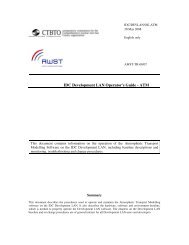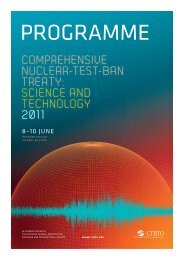CTBTO Spectrum - December 2002 Issue 1 - Comprehensive ...
CTBTO Spectrum - December 2002 Issue 1 - Comprehensive ...
CTBTO Spectrum - December 2002 Issue 1 - Comprehensive ...
You also want an ePaper? Increase the reach of your titles
YUMPU automatically turns print PDFs into web optimized ePapers that Google loves.
PerspectivesCTBT – The Arms Control Holy Grailby Peter D. Marshall, O.B.E.With the signing ofthe <strong>Comprehensive</strong>Nuclear-Test-BanTreaty (CTBT) on24 September 1996the most significantstep towards nuclearnon-proliferationsince the signing ofthe Nulcear Non-Proliferation Treaty wastaken. The <strong>CTBTO</strong> PreparatoryCommission which, together with itsProvisional Technical Secretariat (PTS), isto establish all the facilities specified inthe Treaty to enable States Signatories toverify compliance with the provisions ofthe Treaty, started work shortly afterwards.The CTBT contained an unprecedentedtechnical verification package, includingthe establishment of a total of 321seismological, hydroacoustic, infrasoundand radionuclide monitoring stations in 90countries – the International MonitoringSystem (IMS). In addition to theestablishment of the IMS, the PreparatoryCommission had to create an InternationalData Centre (IDC) and to define theprocess required to conduct an on-siteinspection (OSI).“The IMS is to earth scientistswhat the Hubble telescope is toastronomers or the latest atomsmasherto nuclear scientists.”The build-up of theverification regimeThe task of establishing the IMS andIDC systems, as well as the OSIprocedures, is a major engineering andlogistical challenge. Where no stationscurrently exist, a specific procedure,which can be very time consuming, mustbe followed. Agreements have to benegotiated with host States to allow PTSstaff to enter that State's territory to carryout work. Once this has been done, sitesurveys are conducted to ensure that theproposed location is adequate for thepurpose of Treaty monitoring. The nextstage is to acquire the equipment –which for each of the technologies is ofthe highest specification – and arrangefor its installation. A satellitecommunication link, part of the GlobalCommunication Infrastructure (GCI), isset up to get the data to the IDC inVienna. The IDC uses this data toprepare a bulletin of events detected andlocated for distribution within two daysto all States who wish to receive it.These bulletins can be tailor-made to aState Signatory's individual monitoringrequirements.The status of the IMSnetworkAt the present time onlypart of the IMS isoperational. The speed atwhich stations areinstalled is determined bya number of factors,including budgetaryconstraints and theavailability of specialisedequipment. What isalready clear is that the performance ofthe final IMS network for Treatymonitoring will significantly exceedthe necessarily conservative estimatesof the experts in Geneva whoestablished the original specifications.Other potential uses of theCTBT verificationtechnologiesOnce the IMS and the IDC are complete,the State Signatories will have access toa unique database. Much of this datacould be of very significant value for avariety of scientific studies which wouldbenefit mankind as well as provideassurance that the provisions of theCTBT are being adhered to. Earthquakehazard and risk assessment, monitoringof global warming, atmospheric andmeteorological studies, early warning ofthe potential dangers of volcaniceruption and studies of pollutant andbiological species are just a few of thestudies which would benefit from timelyaccess to the IMS data. The IMS is toearth scientists what the Hubbletelescope is to astronomers or the latestatom-smasher to nuclear scientists.OVERVIEW OF THIRTEEN IMS STATIONS LOCATED IN ANTARCTICAPAGE 10<strong>CTBTO</strong> SPECTRUM 1 | WWW.<strong>CTBTO</strong>.ORG
















